Electronic Devices for Analog Signal Processing by Yu. K. Rybin

Author:Yu. K. Rybin
Language: eng
Format: epub
Publisher: Springer Netherlands, Dordrecht
However, it is unclear how these conditions can be understood, because they are nonsense for a closed self-oscillating system. Actually, if we consider Fig. 5.2d, where, say, LFDE is a well-known Wien bridge with the gain at the frequency of self-oscillations , and ANE is an amplifier with negative feedback and the gain then these conditions would take the more specific form
Check is it possible to satisfy these conditions in a closed-loop system. Let at some time the voltage at the amplifier input is 1 V. Pass on the feedback loop through the amplifier and the Wien bridge, this voltage becomes equal to 1.1 V at the same time. But 1.1 V is not equal to 1 V. What is the matter? The matter is that in the closed self-oscillating system the loop gain (if this concept can be applied here) is equal to 1 in both the steady-state mode and the excitation mode. Because the left-hand side of Eq. 5.7 it is always equal to the right-hand side. Then what is the amplifier gain or what is the gain of the Wien bridge during excitation? The oscillations increase in spite of these questions, but at what frequency? Obviously, it is not the frequency , since the gain at this frequency must be 3.3. Also it is absolutely unclear at what gain the oscillations are damped, when the loop gain, on one hand, must be less than 1, but on the other hand, it is equal to 1.
Thus the Barkhausen criterion and the amplitude balance and phase balance conditions have limited applicability only to the steady-state mode, but even in this case it is not always possible to determine K fb , for example, in the positive feedback in the amplifier. It is appropriate noting here that it is unclear what these conditions are at other frequencies. And, finally, these conditions are inapplicable to the oscillating systems generating non-sine-wave oscillations.
Download
This site does not store any files on its server. We only index and link to content provided by other sites. Please contact the content providers to delete copyright contents if any and email us, we'll remove relevant links or contents immediately.
| Automotive | Engineering |
| Transportation |
Whiskies Galore by Ian Buxton(41525)
Introduction to Aircraft Design (Cambridge Aerospace Series) by John P. Fielding(32885)
Small Unmanned Fixed-wing Aircraft Design by Andrew J. Keane Andras Sobester James P. Scanlan & András Sóbester & James P. Scanlan(32570)
Craft Beer for the Homebrewer by Michael Agnew(17930)
Turbulence by E. J. Noyes(7695)
The Complete Stick Figure Physics Tutorials by Allen Sarah(7135)
Kaplan MCAT General Chemistry Review by Kaplan(6591)
The Thirst by Nesbo Jo(6432)
Bad Blood by John Carreyrou(6271)
Modelling of Convective Heat and Mass Transfer in Rotating Flows by Igor V. Shevchuk(6219)
Learning SQL by Alan Beaulieu(6031)
Weapons of Math Destruction by Cathy O'Neil(5825)
Man-made Catastrophes and Risk Information Concealment by Dmitry Chernov & Didier Sornette(5644)
Digital Minimalism by Cal Newport;(5388)
Life 3.0: Being Human in the Age of Artificial Intelligence by Tegmark Max(5182)
iGen by Jean M. Twenge(5158)
Secrets of Antigravity Propulsion: Tesla, UFOs, and Classified Aerospace Technology by Ph.D. Paul A. Laviolette(4984)
Design of Trajectory Optimization Approach for Space Maneuver Vehicle Skip Entry Problems by Runqi Chai & Al Savvaris & Antonios Tsourdos & Senchun Chai(4837)
Electronic Devices & Circuits by Jacob Millman & Christos C. Halkias(4743)
